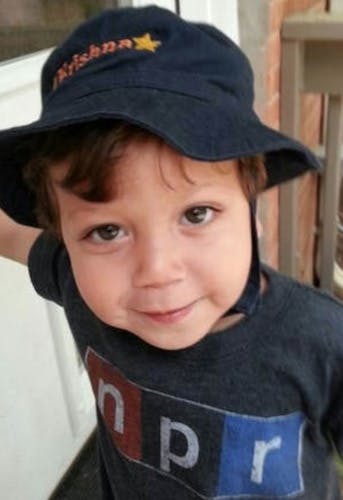Black and Brown and White-ish Make ... Family
By Gita Gulati-Partee

The author with her husband and adopted child
I always knew I wanted to adopt. Even as a child, when we would play family, mine always included a motley crew of adopted kids.
I was moved by the plight of poor kids in my family’s native India, as well as the kids I saw on TV commercials about famine in various parts of Africa, and my maternal instinct was to just swoop ’em all up in my version of “Diff’rent Strokes.”This was the ‘70s, well before Madonna and other celebrities started assembling their global families. So I’m not sure where I got the idea, but it was just always the way I envisioned my family coming together and my life playing out.
I met Edd, who is black, in college, and we committed to each other soon after graduation. I told him about my dream of adoption, though I was open to old-fashioned reproduction if that felt important to him. He thought about it for a while, and it became clear he was on board when I overheard him say in response to somebody’s query about parenting that he felt it was more important to pass on your values than your genes.
With our minds set on adoption as the path to parenthood, we avoided the pressure of the biological clock. So we took our time. A long time. It wasn’t until after my 40th birthday, when my business felt solid, and we had a good home in a family-friendly neighborhood, that we turned our attention to the process of adoption.
Walking the provocative road to adoption
Growing up in eastern North Carolina as the daughter of Hindu immigrants from India, I have a visceral resistance to Christian dominance. Based on my initial search for adoption agencies serving North Carolina, I begrudgingly accepted that our decision to adopt likely would require us to engage with an agency with either an explicit or implicit Christian orientation. But that was not the worst of our expectations.
We soon learned that a common practice of adoption agencies is to price the adoption based on the race of the child — African American and other kids of color come at a discount, white kids at a premium, and mixed race kids somewhere in between. I accepted the fact that we would have to hold our noses and endure all sorts of personal affronts in order to find our way to our child.
So we were pleasantly surprised to stumble upon the Independent Adoption Center, a California-based nonprofit agency with a North Carolina office. The pictures on the home page — I recall a Latino heterosexual couple, a white single woman, and a white gay couple — brought to life their tag line at the time, “We bring families together,” and seemed to mirror our own multi-racial family as well as our values and politics. And they did not have race-based pricing! In fact, we learned that their costs were on a sliding scale based on the adoptive parents’ income.
IAC is a pioneer in “open adoption,” which means the adoptive family and birth family meet each other and maintain some degree of contact (I will write more about our experience with open adoption in another post). We were especially impressed by IAC’s thoughtfulness about transracial adoption.
We were open to adopting a child with a racial identity different from ours — after all, Edd and I were already “different” from each other, so why quibble? The extra questionnaire included questions like:
- What experience(s) do you have dealing with prejudice, or with being treated differently? How might this experience help you in raising a child of a different ethnicity than your own?
- Have you investigated the demographics of your local schools and neighborhood? Are there children/families who represent the races/ethnicities that you have chosen? If not, how will you introduce your child to others of his/her ethnicity for peers and role models?
- Why is the approach of “We can love a baby, no matter what the color,” not sufficient enough to be prepared for a cross-cultural/transracial adoption?
These were all excellent, thought-provoking questions. But it was obvious that their approach, and other resources we found online, were based on the assumption that white adoptive parents would be opening their hearts and homes to kids of color. Parents of color like us were definitely not the target audience.
Nonetheless, Edd and I took the exercise seriously. A couple questions gave us pause:
- Are you willing to acknowledge ALL ethnic heritages of your child equally, including those that are different from your own and/or those that represent a small percentage of your child’s ethnic makeup?
- How would you introduce your child to his or her cultural heritage if it is different from your own?
For the first time, we discussed the possibility that our child could be part-white. How would we handle that?
Our uneasy relationship to whiteness
Edd’s experience as a black man and mine as a brown woman had led both of us to feel suspicious, at best, of whiteness. We regularly unloaded our frustrations — about micro and sometimes macro-aggressions we had endured or unchecked privilege we had witnessed — each evening in the relative safety of our own home.
How would we introduce our child to his or her whiteness and help cultivate a strong, but not superior, sense of self? How could we talk about white privilege and supremacy honestly but without injecting a sense of shame? And how would we celebrate a culture that already dominates all of our lives, often in destructive ways?
Beyond Italian food, French wine, Belgian chocolate, and Scandinavian furniture… what positives had we experienced from whiteness? (Note that “whiteness” is a power apparatus — a thing, not a person. Some of our best friends are white — for real — and we can name many positives about them as people.)
With no easy answers, we took the next best path — denial. The odds of us adopting a white child were incredibly remote, we told ourselves. The math just didn’t work that way. There were plenty of white parents eager for an all-white or at least part-white baby, which are relatively hard to come by. Parents of color like us would have our pick among the abundance of babies of color available for adoption.
But as any fourth grader can tell you, math has nothing to do with real life. About half of the birth mothers we spoke with were white. And the one we ultimately matched with was a white woman who had two mixed race children with her black partner.
Kelly and Terry (not their real names) chose adoption because they did not feel able to parent a third child. They said they chose us because we had a strong family and community and because they wanted parents of color for their mixed-race child. We couldn’t help but notice that their two sons of color were… whiteish — they were light skinned, one had gray-blue eyes, and both had curly “white hair.” Though beautiful and delightful, this was not what we had anticipated.
Once we had a match agreement in place, IAC required that Edd and I complete some education modules related to transracial adoption. We watched videos created by PACT, a national resource for adopted kids of color. The materials were impressive, but once again geared toward white parents adopting a child of color. Once again, we encountered assumptions about how hard it might be to expose our child to their cultural heritage — not a problem for a part-white child in a white dominant country.
One piece really moved us. It focused on how to react when your (presumably black or brown) child comes home and tells (presumably white) you that they experienced racism. The video advised it was critically important to believe your child. For one, the video asserted, racism is alive and well and your child’s assessment is probably accurate. But also, the video noted, because the perpetrator likely would share a racial identity with the adoptive parent, it would be important to stand up for your child, set yourself apart from the perpetrator, and proactively demonstrate that you are on their side.
This sounded like very wise counsel… that had little relevance to us. We had to work hard to translate the scenarios and advice to our impending circumstance. What came to us was imagining the possibility that our light-skinned child might witness his or her darker-skinned parents experience racism; that he or she might worry that they are connected to our white perpetrator; and that our job would be to help our child navigate their likely mix of feelings — fear, outrage, guilt. Suddenly, the stakes felt really high, and the relative uniqueness of our situation felt both exciting and daunting.
A work in progress…

Krishna, the author's son
Fast forward to today, our son Krishna is three-and-a-half years old. He is beautiful and brilliant and perfect in every way. And all three of us are figuring it out together — who he is, who we are as a family, how we relate to our world.
I was drawn to EmbraceRace not because I have any certainty or profound wisdom to share, but rather a real-time mystery to unravel.
In future posts, I look forward to exploring more about our adoption experience, how we are helping Krishna make sense of his identity even as we are still figuring out our own, how we experience differences between us and white parents as well as other parents of color in terms of values and approaches, and more.
I welcome your thoughts and questions along the way.

Gita Gulati-Partee
Get Insights In your Inbox
Join the EmbraceRace community! You will receive the newsletter with our latest on race & kids, including upcoming events and opportunities, resources, community news and curated links.
Subscribe


